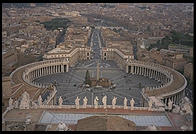
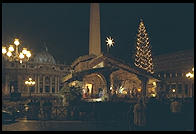 One of the last
cathedrals in the world to be built, it is also the largest, reflecting the
unlimited ambitions of Renaissance Man. Consecrated in 1623, the cathedral is
exclusively decorated with mosaics and sculpture. There are no paintings in the
cathedral, even though a lot of the mosaics look remarkably like oil
paintings.
One of the last
cathedrals in the world to be built, it is also the largest, reflecting the
unlimited ambitions of Renaissance Man. Consecrated in 1623, the cathedral is
exclusively decorated with mosaics and sculpture. There are no paintings in the
cathedral, even though a lot of the mosaics look remarkably like oil
paintings.
Michelangelo designed the dome, which is relatively easy to climb these days because an elevator gets you halfway to the top. Michelangelo also contributed the Pietà, a statue of Mary holding the dead Jesus completed in 1499, when Michelangelo was 25. An Australian tourist attacked Jesus's foot with a hammer in 1972 and the statue now sits behind glass. You might do better to examine the replica in the Pinocoteca of the Vatican Museums.
Bernini did the colonnade that embraces visitors to St. Peter's. His intent was that people would be greeted by surprise when they stumbled upon the vast courtyard after wandering through the narrow streets of the quarter. Mussolini, attempting to curry favor with the Church, bulldozed a vast avenue right up to the colonnade in the 1920's. [Note that Hitler did something similar with Unter den Linden in Berlin.]
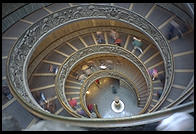
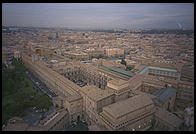 Remarkable first for being open on
Mondays and closed on Sundays. Remarkable second for the ceilings. Not the
Sistine Chapel, but random ceilings throughout the hundreds of rooms formerly
occupied by Renaissance popes. Every ceiling is decorated with dozens of fine
paintings. There is none of that "motel textured white paint" stuff here.
Remarkable first for being open on
Mondays and closed on Sundays. Remarkable second for the ceilings. Not the
Sistine Chapel, but random ceilings throughout the hundreds of rooms formerly
occupied by Renaissance popes. Every ceiling is decorated with dozens of fine
paintings. There is none of that "motel textured white paint" stuff here.
These are some of the best collections in the world and they show just how much great stuff you can accumulate when you have almost all of the money in the world for centuries. The only thing in modern times remotely comparable to the Catholic Church's absolute dominance of the world is Microsoft's monopoly. Unfortunately, although Bill Gates has bought the electronic rights to nearly all of the world's art treasures, he doesn't seem to have the refined taste of the popes.
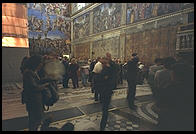 When you're looking up at the ceiling frescoes of the Sistine Chapel, note that
Michelangelo's style changed quite a bit from 1508 when he started to 1512 when
he finished. He started the ceiling at the back and worked toward the front. The
flood panel, second from the back wall, contains lots of figures, most of which
are barely recognizable from the floor of the chapel. Michelangelo realized that
he needed to paint fewer and bigger figures and the last panels (God dividing
Light from Darkness, Creation of the Sun and Moon) reflect that growth.
When you're looking up at the ceiling frescoes of the Sistine Chapel, note that
Michelangelo's style changed quite a bit from 1508 when he started to 1512 when
he finished. He started the ceiling at the back and worked toward the front. The
flood panel, second from the back wall, contains lots of figures, most of which
are barely recognizable from the floor of the chapel. Michelangelo realized that
he needed to paint fewer and bigger figures and the last panels (God dividing
Light from Darkness, Creation of the Sun and Moon) reflect that growth.
At the very front of the Sistine Chapel is Michelangelo's huge fresco of the
Last Judgment, completed in 1541 after seven years of unassisted labor. There is
no separation between people who are going up to heaven and those who are being
sent down to hell. Everything is a swirl of motion. Biagio da Cesena objected to
the use of nudes in the fresco and earned an appearance as the infernal judge
Minos for his pains, as well as a pair of ass's ears. Unfortunately, Biagio da
Cesena had the last laugh because Pope Pius IV hired Daniele da Volterra to cover
all the genitals with loin cloths.
This is about as much as most people are going to see...
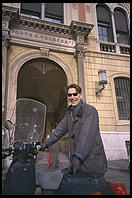 I was staying at a friend's house some distance from the center of Rome. I
stopped in the local tabaccheria and asked for four bus tickets. The
proprietor explained that the bus drivers were on strike today so that there was
only limited service. He asked where I wanted to go. I said "Castel Sant'Angelo".
He said, "I have to go into the center; I'll give you a ride there on my
Vespa."
I was staying at a friend's house some distance from the center of Rome. I
stopped in the local tabaccheria and asked for four bus tickets. The
proprietor explained that the bus drivers were on strike today so that there was
only limited service. He asked where I wanted to go. I said "Castel Sant'Angelo".
He said, "I have to go into the center; I'll give you a ride there on my
Vespa."
Sergio only had to go to the Post Office to stock up on stamps for his shop, but he dropped me off right at the door of the old tomb of the Emperor Hadrian. It was completed in 139 AD, incorporated into the Aurelian Wall in 271 AD, visited by the Archangel Michael in 590 AD (hence the current name), connected to the Vatican in 1277 via a secret escape route for the pope in times of trouble, used as a military barracks and prison in 1870, and served as a launching pad for Tosca in Puccini's Tosca. Now it is a tourist attaction that gets three stars in the Michelin guide. I'm not really sure why because there isn't so much to see in the huge fortress, but the view from the top is worth the price of admission and the climb. You can enjoy the same view and a snack from the tables at the bar, about three quarters of the way to the top.